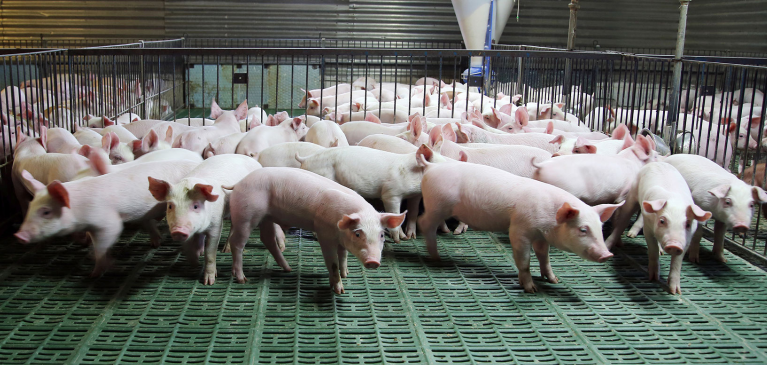
There are definite pros and cons affecting the current hog industry, but economists believe hog farmers have every reason to be optimistic going into 2022, as long as the U.S. can keep foreign animal diseases (FAD) such as African swine fever (ASF) out of the country.
ASF is found in countries around the world. More recently, it has spread to the Dominican Republic and Haiti. ASF has also spread through China, Mongolia, and Vietnam, as well as within parts of the European Union. It has never been found in the United States and producers are working hard to keep it that way.
Should a FAD like ASF or foot-and-mouth disease be detected in a U.S. herd, exports would immediately be shut down resulting in an oversupply of the U.S. market and dramatically lower prices.
“Farmers have long been focused on keeping disease out of their farms via biosecurity protocols, but have been seeking and implementing additional biosecurity measures given this increased risk,” says Kyle Hurley, GreenStone Farm Credit Services, vice president of agribusiness lending.
The 2022 forecast follows a banner year in 2021, which helped soothe the wounds created by the 2020 pandemic. Hog prices rebounded sharply in 2021, allowing for moderate to strong profitability following a very difficult 2020, during which most operations endured significant operating losses due to the disruptions in the food supply chain (particularly pork processing) caused by Covid-19. This resulted in low prices, backed up sales, and in the worst cases, depopulation of hog inventories.
“The reduced supply of hogs in 2021, coupled with strong domestic and export demand, resulted in one of the strongest years for earnings for producers, which was much needed,” said Hurley, but warns he expects 2022 profit margins to tighten.
“Cautious optimism is how I would characterize farmer sentiment and the industry outlook for the year ahead,” he added. “Year-to-date prices have been profitable and the futures markets, at present, provide additional profit opportunities for the next two quarters and an above average 4th quarter (losses in Q4 are the typical pattern).”
Supplies are expected to remain short. Most contract months on the CME are at or near contract highs, according to Hurley, and are at the highest prices since 2014.
“This does create significant opportunities for producers to hedge or forward contract sales at profitable margins at their current cost of production, despite higher feed prices and increasing labor costs,” he said.
As of the last quarterly USDA Hogs and Pigs Report (Dec. 21), U.S. market hog inventories are down 4% over a year ago, due in part to reduced sow numbers beginning in 2020, but also from health challenges the industry has been combatting.
Particularly, certain strains of PRRS (porcine reproductive and respiratory syndrome) have resulted in increased reproductive issues and mortality in all phases of production.
“Given the market volatility, prior years’ losses, health challenges, increased potential production regulations (like California’s Prop-12), and supply chain issues resulting in higher costs and delays in obtaining building materials, there is very little expansion happening or expected in U.S. sow numbers and hogs marketed through 2022,” Hurley said.
According to the USDA March 15 Market Outlook report, 2022 pork production forecast is reduced by 65 million pounds from last month on lower-than-expected February slaughter numbers, the likelihood of higher average carcass weights in the second half of the year, and evidence of elevated disease risks, also late in the year.
The upside of this stagnation in expansion – pork supplies remain below year-ago levels – is an extended period of profitability for the industry.
The United States is the world's third-largest producer and consumer of pork and pork products. In recent years, the U.S. has been either the world’s largest or second-largest exporter of pork and pork products, with exports averaging over 20% of commercial pork production in most years.
U.S. hog prices depend on domestic meat demand as well as the ability of the industry to export pork out of the country, according to Scott Brown, an economist at the University of Missouri. Strong exports of U.S. pork to China will move hog prices higher, while a reduction could make prices move lower.
Forecasts for U.S. pork exports in the first and second quarters of 2022 are reduced on weaker demand prospects in major importing regions. Total 2022 exports are expected to be 6.73 billion pounds, 4.3% below last year, according to USDA.
Despite that, “Exports should continue to support higher prices given global pork production issues and increased demand for protein,” Hurley said.
Two production hurdles cutting into profits are feed and labor costs.
“Feed costs are one of the strong headwinds facing farmers,” Hurley said. “Driven by historically very high prices for corn and soybean meal, other feed ingredient costs are also significantly higher due to logistics issues and increased manufacturing costs.”
Currently, many production systems are operating with less than a full staff.
“In some cases, they have multiple positions to fill given competition for labor with local non-farm employers,” Hurley said. “To keep employees in a very tight labor market, producers have found it necessary to increase wages and/or benefits significantly in the last 3-6 months.”


